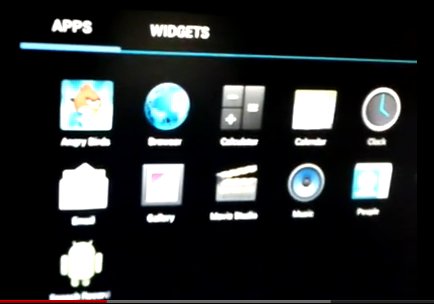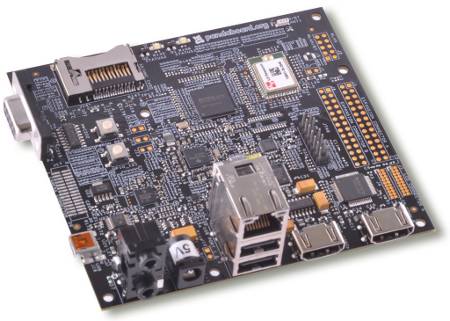PandaBoard demo’d running Android 4.0
Nov 16, 2011 — by Eric Brown — from the LinuxDevices Archive — 8 viewsPandaBoard.org's community-driven PandaBoard is the first device to run Android 4.0, according to Texas Instruments (TI) and the Android Open-Source Project (AOSP). Based on TI's dual-core, 1GHz OMAP4430 processor — similar to the OMAP4460 available in the soon-to-ship Samsung Galaxy Nexus — the PandaBoard has been demonstrated on YouTube running an experimental build of “Ice Cream Sandwich.”
Announced in Oct. 2010, PandaBoard.org's Digi-Key-distributed PandaBoard was the first hobbyist-focused open source board to come with a Cortex-A9 processor, TI's dual-core, 1GHz OMAP4430 system-on-chip (SoC). Now, it's the first embedded platform of any kind to run Android 4.0 ("Ice Cream Sandwich"), according to TI and Google's Android project.
The Samsung Galaxy Nexus, which runs on a similar OMAP4460 SoC, will be the first commercial device to include Ice Cream Sandwich (ICS) when it rolls out on Verizon Wireless later this month (probably Nov. 21).

Screenshot from Android 4.0 running on PandaBoard on YouTube
Source: Zach Feffer
Meanwhile, Linaro's Zach Feffer ("pfefferzlinaro") released a YouTube video showing the PandaBoard running Android 4.0. The video shows the ICS build loading a web browser and running a YouTube video. (Linaro is an ARM-backed open source development firm that supports the PandaBoard, among other platforms, with its Linux-based Linaro middleware stack.)
Since it could be two months or more before other Android smartphones and tablets start appearing with Android 4.0, the PandaBoard offers an affordable way to try the operating system. In addition, the PandaBoard ICS support should allow developers to start prototyping Android 4.0 on a wide variety of device formats, from tablets to set-top boxes. With the open source release of ICS, more ROMs will likely soon appear on other devices, but the PandaBoard has a significant head start.
PandaBoard background
In its first year, more than 8,900 PandaBoard units have been sold, says PandaBoard.org. In addition, the project, which is based on the BeagelBoard.org open platform model, boasts more than 1,000 community members working on more than 70 related projects. Nine Linux distributions have been ported to the board, says the project.

PandaBoard
(Click to enlarge)
The PandaBoard is further equipped with TI's multipurpose wireless chip, the WiLink 7.0, which integrates 802.11b/g/n Wi-Fi with Bluetooth 2.1 + EDR, FM radio, and a GPS receiver. The board also provides a 10/100 Ethernet port, dual USB 2.0 host ports, and a USB 2.0 On-The-Go port.
Additional I/O includes an RS-232 port, camera connector, JTAG port, and stereo audio I/O. There's also an expansion connector that supports interfaces like SD/MMC, USB, GPMC, DSS, ETM, McSPI, I2C, and UARTs.
Android 4.0 running on PandaBoard on YouTube
Source: Zach Feffer
(Click to play)
Wide-range view of Android 4.0 running on PandaBoard on YouTube
Source: Zach Feffer
(Click to play)
The Android 4.0 build for the PandaBoard appears to be available now as an experimental build. More details may be found in this AOSP Android 4.0 support page.
More information on the PandaBoard may be found at PandaBoard.org, and more on the OMAP4/ICS connection may be found in this Oct. 18 TI blog posting by Remi El-Ouazzane.
This article was originally published on LinuxDevices.com and has been donated to the open source community by QuinStreet Inc. Please visit LinuxToday.com for up-to-date news and articles about Linux and open source.